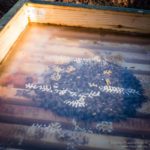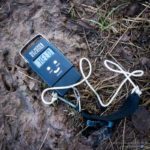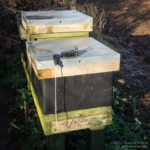Midwinter blues
The short days of late December and early January are a time for working in the shed, drinking copious mugs of scalding tea and preparing for the coming season. I haven’t done a full colony inspection since late August and don’t expect to start until late March or early April (usually about when the ornamental current, RIbes, is in full flower). Other than feeding fondant in the autumn and ensuring the hives are weathertight and woodpecker-proof there’s little to do.
Oxalic acid
I almost always treat colonies with oxalic acid in midwinter, irrespective of whether the colony was treated with Apiguard in the autumn. I did this a week or so ago during a period of cold, settled weather. The weather was ideal, 3ºC with no wind. Together this ensures that the bees are clustered tightly and are discouraged from flying. I prepare 3.2% oxalic acid solution in 1:1 w/v syrup (for a dozen or so colonies 500g sugar, 500ml water and 37.5g oxalic acid dihydrate should be ample), warmed to about 30ºC and transported in a well-labelled Thermos flask. I use a Trickle 2 dispenser from Thorne’s to deliver 5ml per seam of bees. The colony must be opened gently and there’s usually no need to use smoke. I always wear a beesuit for protection just incase they’re more lively than expected. However, the low temperature usually means they are both clustered tightly and less likely to fly – both make the task of application easier. The entire process takes under a minute per colony and hardly disturbs the bees, as shown in this video I prepared last year for a talk on Varroa.
There is an additional video showing treatment of a larger colony and use of the Trickle 2 dispenser. While the crownboard is off I scan the tops of the visible comb for remaining sealed stores. I carefully close the colony up and insert a Varroa tray to monitor mite drop over the following few days.
Of the colonies treated this year, all but one had a mite drop of <30 in the first 24 hours. This included a couple of nucs that were not treated with Apiguard. The mites continue to drop over the next 2-4 weeks and I usually monitor for a maximum of about 5 days, by which time the daily drop should be tailing off significantly. The number that drop is related to the number in the colony accessible to treatment … in turn this must be due to the number present in the colony after the autumn Apiguard treatment, the amount of brood rearing that has gone on subsequently and the amount of sealed brood present at the time OA was added. I therefore keep the mite drop records and look carefully at colonies with high winter levels during the spring build up. These may be candidates for a shook swarm – to give a brood break – in due course.
Routine winter checks
I only infrequently check my colonies over the winter. I ensure the entrances of the hives with Kewl floors are clear using a bent piece of wire (I lost a double brood colony a few years ago after the entrance got blocked with corpses during a very long cold spell). I sometimes check the movement of the cluster by peering through the Perspex crownboard. Finally, I “heft” the colony to check there are sufficient stores present. This is a rather inexact process – particularly with a mix of equipment and colonies on single brood or brood and a half – and so I’ve started weighing colonies using a set of digital luggage scales. There are 6mm holes each side of the floor into which a bolt – attached to the scales – can be pushed (see pictures) allowing the colony to be gently lifted, one side at a time, recording the sum of the weights. This is largely to record the rate they are using stores, rather than identify dangerously light colonies. Stores usage should increase once they start rearing new brood early in the season.
All of these checks take only a few minutes per apiary, meaning I can get back to the warmth of shed for more tinkering (and another cup of tea) for the season ahead.
- Winter cluster …
- Friendly scales …
- Weighing a hive …



Join the discussion ...